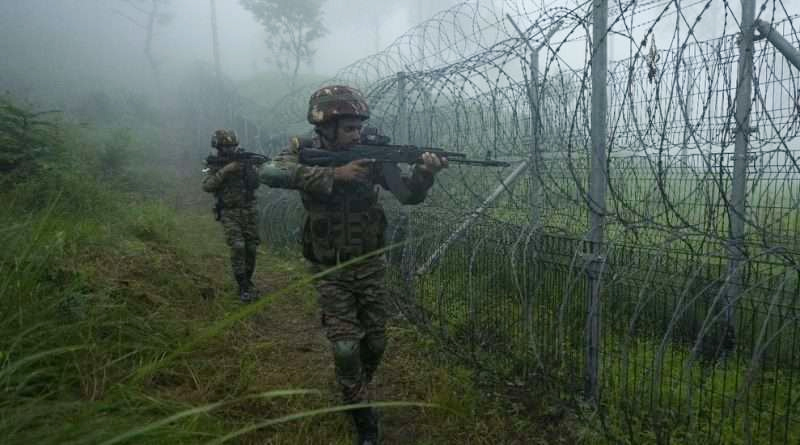news details |
|
|
| Smart fence system, robotic mules, all terrain vehicles boost border security along LoC | | |  Early Times Report Early Times Report
SUNDERBANI, Aug 13: Keeping pace with the changing security scenario driven by rapid advancement in AI-powered technology, the Army has gone high-tech with the introduction of state-of-the-art equipment like smart fence system, robotic mules and all-terrain vehicles to fortify security along the Line of Control (LoC) in Jammu and Kashmir’s Rajouri district, officials said.
The newly-introduced equipment, including quadcopters, advanced surveillance tools, bulletproof vehicles, modern weapons and night-vision sights, were all successfully tested during Operation Sindoor between May 7 and May 10, when Indian armed forces carried out missile strikes on terror infrastructure in Pakistan and Pakistan-occupied Kashmir (PoK) in the wake of the April 22 Pahalgam attack and successfully countered the enemy retaliation.
Providing a rare opportunity to visiting mediapersons to witness the Indian Army’s unwavering courage and dedication along the LoC in the remote regions of Sunderbani ahead of Independence Day, the Army has activated a three-layered security system and intensified patrolling and vigil all along the border to ensure peaceful celebrations of the event.
The induction of advanced military vehicles like the Armado and all-terrain vehicles have given the Army’s quick-reaction teams an advantage to act swiftly in the most challenging and rugged terrain with dense foliage to neutralise any threat, especially from infiltrating terrorists, the officials said.
During a drill, the soldiers demonstrated how they cordon off an area and engage terrorists, highlighting the vehicles’ speed, protection and adaptability.
The Mahindra Armoured Light Specialist Vehicle (ALSV) or Armado is a lightweight and air-transportable armoured vehicle designed for the Army and special forces.
The indigenously-developed “Robotic Mule” is emerging as a game-changer on the battlefield, the officials said, adding that the MULE (Multi-Utility Legged Equipment), designed by AeroArc under the “Make in India” initiative, is a quadrupedal robot capable of navigating snow, deserts, water and other challenging terrains to complete the assigned job.
During Operation Sindoor, these robotic mules played a crucial role in surveillance and logistics, an Army official said.
Equipped with advanced sensors, he said the MULE can transport supplies, detect explosives and conduct reconnaissance. Its modular design allows for customisation across various battlefield roles and it can even operate in swarms, creating a “mini robot army” that enhances operational efficiency while reducing risks to soldiers.
The official said the Army is increasingly integrating drones into military operations for surveillance, reconnaissance and potential strike missions.
Among them, the Mini Unmanned Aerial Vehicles (UAVs) and Surveillance Drones have emerged as a key asset for monitoring sensitive areas, he said.
In addition to the Mini UAV, the Army also employs other advanced surveillance drones capable of not just monitoring but also engaging targets.
Equipped with precision-dropping mechanisms, these drones can hit enemy targets with grenades and improvised explosive devices (IEDs) without exposing the soldiers, the official said.
The Indian Army’s Battle Obstacle Course (BOC) is a gruelling test of endurance, strength and combat readiness. It simulates real battlefield conditions, including terrain challenges, jungle operations and bunker-busting exercises.
As part of the drill, an infantry unit demonstrated how enemy bunkers are captured moving through rugged terrain, breaching defences and neutralising threats.
The BOC not only hones soldiers’ physical capabilities but also sharpens coordination, speed and tactical skills, which are very essential in combat, the official said.
He said the Army has intensified patrolling and set up a three-layered security system along the LoC to thwart any attempt by terrorists to disrupt Independence-Day celebrations on August 15.
Besides the regular patrolling to keep a close watch on enemy activities, the Army is using drones to monitor every movement of the enemy, while dog squads and detectors are being deployed for additional security.
The official said this is the first Independence Day post Operation Sindoor during which the Army destroyed a number of terrorist camps across the LoC.
A defence spokesperson said the soldiers guarding the border face formidable challenges and steadfastly defend the country with determination and selflessness.
“It became clear that beyond their uniforms, each soldier harbours a deep sense of duty and pride in safeguarding the homeland,” he said.
Amidst the breathtaking yet unforgiving landscapes, he said the soldiers display an indomitable spirit as they tackle adversities with an unwavering commitment and assuring smile.
“Despite extreme weather conditions, isolation and the constant demand for vigilance, these soldiers embody remarkable resilience. In addition to their duties, the soldiers maintain rigorous training standards, underscoring the necessity of being prepared for any challenge,” he said.
He said this commitment to continuously evolve, change and integrate exemplifies the Indian Army’s dedication to maintain peak operational readiness.
The spokesperson said the Army’s outreach to civilians is equally noteworthy, as it works to build bridges with local communities, ensuring that peace and development reach even the most remote areas. |
|
|
|
|
|
|
|
|
|
|
|
|
| |
| |
|
|
|
|
 |
|
|
